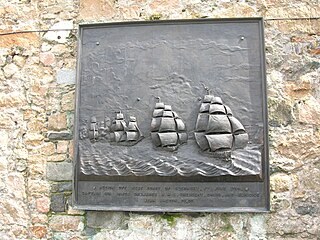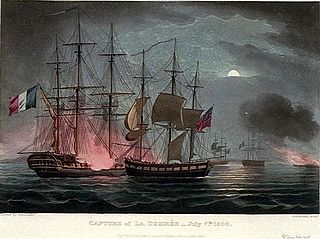
HMS Galatea was a fifth-rate 32-gun sailing frigate of the British Royal Navy that George Parsons built at Bursledon and launched in 1794. Before she was broken up in 1809 she captured numerous prizes and participated in a number of actions, first in the Channel and off Ireland (1794–1803), and then in the Caribbean (1802–1809), including one that earned her crew the Naval General Service Medal.
HMS Pickle was a topsail schooner of the Royal Navy. She was originally a civilian vessel named Sting, of six guns, that Lord Hugh Seymour purchased to use as a tender on the Jamaica station. Pickle was at the Battle of Trafalgar, and though she was too small to take part in the fighting, Pickle was the first ship to bring the news of Nelson's victory to Great Britain. She also participated in a notable single-ship action when she captured the French privateer Favorite in 1807. Pickle was wrecked in 1808, but without loss of life.

HMS Glatton was a 56-gun fourth rate of the Royal Navy. Wells & Co. of Blackwell launched her on 29 November 1792 for the British East India Company (EIC) as the East Indiaman Glatton. The Royal Navy bought her in 1795 and converted her into a warship. Glatton was unusual in that for a time she was the only ship-of-the-line that the Royal Navy had armed exclusively with carronades. She served in the North Sea and the Baltic, and as a transport for convicts to Australia. She then returned to naval service in the Mediterranean. After the end of the Napoleonic Wars the Admiralty converted her to a water depot at Sheerness. In 1830 the Admiralty converted Glatton to a breakwater and sank her at Harwich.

HMS Hannibal was a 74-gun third-rate ship of the line of the Royal Navy, launched on 15 April 1786, named after the Carthaginian general Hannibal. She is best known for having taken part in the Algeciras Campaign, and for having run aground during the First Battle of Algeciras on 5 July 1801, which resulted in her capture. She then served in the French Navy until she was broken up in 1824.

Révolutionnaire, was a 40-gun Seine-class frigate of the French Navy, launched in May 1794. The British captured her in October 1794 and she went on to serve with the Royal Navy until she was broken up in 1822. During this service Revolutionnaire took part in numerous actions, including three for which the Admiralty would in 1847 award clasps to the Naval General Service Medal, and captured several privateers and merchant vessels.

Cléopâtre was a 32-gun Vénus class frigate of the French Navy. She was designed by Jacques-Noël Sané, and had a coppered hull. She was launched in 1781, and the British captured her in 1793. She then served the Royal Navy as HMS Oiseau until she was broken up in 1816.

HMS Tartar was a 32-gun fifth-rate Narcissus-class frigate of the Royal Navy, built at Frindsbury and launched in 1801. She captured privateers on the Jamaica station and fought in the Gunboat War and elsewhere in the Baltic Sea before being lost to grounding off Estonia in 1811.
HMS Cynthia was a ship sloop of unusual design which launched in 1796. She took part in one medal-worthy boat action and participated in captures of a number of merchant vessels. She was present at two notable occasions, the surrender of the Dutch fleet in the Vlieter Incident and the capture of Alexandria, and her crew participated in two land attacks on forts. She was broken up in 1809.
HMS Calpe was the former 14-gun polacca San José of the Spanish Navy, originally built in 1796 in Greece. The British captured her in 1800 and commissioned her as a sloop-of-war. She served at the Battle of Algeciras Bay before the Navy sold her in 1802. She underwent repairs and reappeared as a merchantman in the 1805 registers; however, she wrecked at the Dardanelles in 1805.
During the French Revolutionary and Napoleonic Wars the Admiralty also made use of hired armed vessels, one of which was His Majesty's Hired armed cutter Swan. Actually there were two such cutters, but the descriptions of these vessels and the dates of their service are such that they may well represent one vessel under successive contracts. The vessel or vessels cruised, blockaded, carried despatches and performed reconnaissance.
His Majesty's hired armed cutter Courier appears twice in the records of the British Royal Navy. The size and armament suggests that both contracts could represent the same vessel, but other information indicates that the second Courier had been captured from the French in the West Indies. On the first contract the captain and crew were awarded clasps to the Naval General Service Medal, one for a boat action and one for a single ship action in which they distinguished themselves.

HMS Cruizer was a Royal Navy Cruizer-class brig-sloop built by Stephen Teague of Ipswich and launched in 1797. She was the first ship of the class, but there was a gap of 5 years between her launch and the ordering of the next batch in October 1803; by 1815 a total of 105 other vessels had been ordered to her design. She had an eventful wartime career, mostly in the North Sea, English Channel and the Baltic, and captured some 15 privateers and warships, and many merchant vessels. She also participated in several actions. She was laid up in 1813 and the Commissioners of the Navy sold her for breaking in 1819.

HMS Circe was a 28-gun Enterprise-class sixth-rate frigate of the Royal Navy. She was launched in 1785 but not completed or commissioned until 1790. She then served in the English Channel on the blockade of French ports before she was wrecked in 1803.

His Majesty's hired armed lugger Valiant served the Royal Navy on a contract from 5 May 1794 to 10 November 1801. She was of 109 90⁄94 tons (bm), and was armed with eleven 3-pounder guns.

HMS Childers was a brig-sloop of the British Royal Navy, initially armed with 10 carriage guns which were later increased to 14 guns. The first brig-sloop to be built for the Navy, she was ordered from a commercial builder during the early years of the American War of Independence, and went on to support operations in the English Channel and the Caribbean. Laid up for a time after the end of the American War of Independence, she returned to service shortly before the outbreak of the French Revolutionary Wars. She had an active career in both the French Revolutionary and Napoleonic Wars, capturing numerous French privateers and during the Gunboat War participated in a noteworthy single-ship action. The navy withdrew her from service at the beginning of 1811, at which time she was broken up.
The Royal Navy employed two vessels designated as His Majesty's Hired armed vessel Sir Thomas Pasley during the French Revolutionary Wars. The two vessels were named for Admiral Sir Thomas Pasley. The vessels are also sometimes described as cutters, but more generally as brigs. The Spanish captured the first Sir Thomas Pasley. The second had a brief, but highly productive, career that later led to her crew qualifying for the Naval General Service Medal. After she was returned to her owners in March 1802, she may have been wrecked in the Mediterranean that same year.
HMS Milbrook was one of six vessels built to an experimental design by Sir Samuel Bentham. After the Royal Navy took her into service in her decade-long career she took part in one notable single-ship action and captured several privateers and other vessels, all off the coast of Spain and Portugal. She was wrecked off the coast of Portugal in 1808.

HMS Redbridge was one of four schooner-rigged gunboats built to an experimental design by Sir Samuel Bentham. Her launch date is unknown, but the Admiralty purchased her in April 1798. She had a short, relatively uneventful career before the French captured her in 1803. The French Navy sold her in January 1814.

HMS Dart was one of two sloops built to an experimental design by Sir Samuel Bentham and launched in 1796. She served the Royal Navy during the French Revolutionary wars and the early part of the Napoleonic wars before being sold in 1809 for breaking up.
HMS Cracker was an Acute-class gunbrig, launched in 1797. She was sold in 1802.












